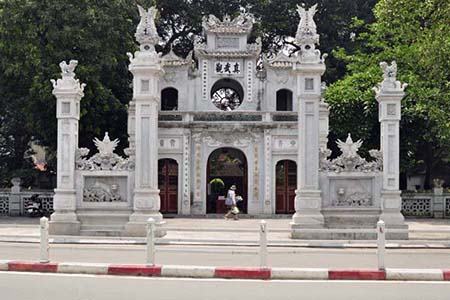Quan Thanh temple is dedicated to the cult of Saint Tran vu, the mythical figure who allegedly helped King An Duong Vuong overcome evil spirits and build the Co Loa fortress...
Quan Thanh temple is dedicated to the cult of Saint Tran Vu, the mythical figure who allegedly helped King An Duong Vuong overcome evil spirits and build the Co Loa fortress.
The temple was initially named Quan Tran Vu, then renamed in 1840 Quan Chan Vu by Emperor Minh Mang. In common parlance, it is now called Quan Thanh Temple. It is located at the end of Quan Thanh Street, Hanoi, by Truc Bach Lake and West Lake. In 1821, Emperor Minh Mang came and held a worship ceremony at this temple, and donated 50 lang of silver (lang: 37.8 grams).
The temple is built on a land area of 3,500 sq. metres (length: 70m; width: Sam). It comprises the two-compartment Antechamber and the two- compartment Inner Chamber which are similar both in length and width and are connected with each other. The foundation and floor of both chambers is rectangular in form, 30m in length and 14m in width and on an East-West axis. The architectural pattern of the temple is somewhat similar to the Greek-Roman one in the sense that its main entrance facade is on the shorter side of the rectangle. There are several exits on both sides into the courtyard and garden.

Behind the Inner Chamber is the Back House including 3 auxiliary places of worship. The Inner Chamber contains a 3.96m high statue cast in 1677 which occupies most of the height of the compartment. It weight 4 tons and is seated on a stone pedestal. That is the statue of Saint Tran Vu, in a sitting position, one hand holding the handle of the sword which is pointed at the back of a tortoise, while a snake climbs along the blade of the sword.
Believing that Saint Tran Vu is a benefactor with supernatural powers, many persons usually rub the legs of the statue with towels or handkerchiefs with which they then clean their faces. As a result, these legs have been polished and somewhat worn out.
The temple is said to have been built during the Ly dynasty. It was repaired by Kings Le Nhan Tong (1443 -1453) and Le Thanh Tong (1406- 1469). Major repairs were carried out during the reign of King Le Hy Tong and Lord Trinh (late 17th century). Further repairs and renovations took place in 1768, 1843, 1893 and 1941.
The stone stele and various documents written by governor Hoang Cao Khai, which are preserved at the temple, say that it was constructed under the Ly dynasty



